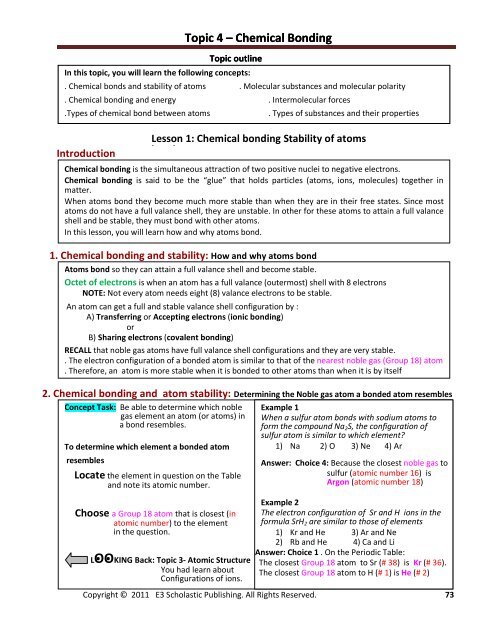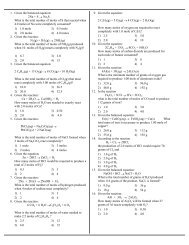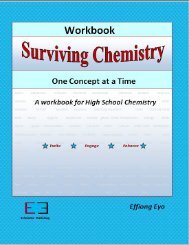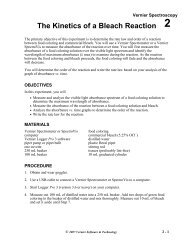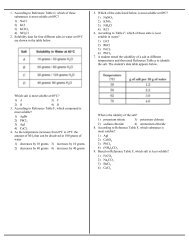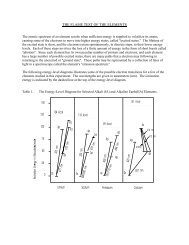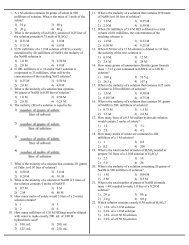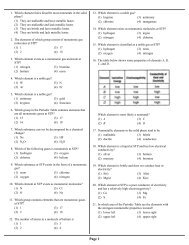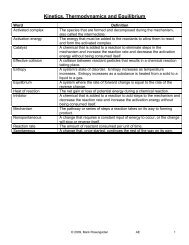Topic 1 - Matter and Energy - Revsworld
Topic 1 - Matter and Energy - Revsworld
Topic 1 - Matter and Energy - Revsworld
You also want an ePaper? Increase the reach of your titles
YUMPU automatically turns print PDFs into web optimized ePapers that Google loves.
<strong>Topic</strong> 4 – Chemical .<br />
Bonding<br />
<strong>Topic</strong> outline<br />
In this topic, you will learn the following concepts:<br />
. Chemical bonds <strong>and</strong> stability of atoms . Molecular substances <strong>and</strong> molecular polarity<br />
. Chemical bonding <strong>and</strong> energy . Intermolecular forces<br />
.Types of chemical bond between atoms<br />
Introduction<br />
. Types of substances <strong>and</strong> their properties<br />
1. Chemical bonding <strong>and</strong> stability: How <strong>and</strong> why atoms bond<br />
Atoms bond so they can attain a full valance shell <strong>and</strong> become stable.<br />
Octet of electrons is when an atom has a full valance (outermost) shell with 8 electrons<br />
NOTE: Not every atom needs eight (8) valance electrons to be stable.<br />
An atom can get a full <strong>and</strong> stable valance shell configuration by :<br />
A) Transferring or Accepting electrons (ionic bonding)<br />
or<br />
B) Sharing electrons (covalent bonding)<br />
RECALL that noble gas atoms have full valance shell configurations <strong>and</strong> they are very stable.<br />
. The electron configuration of a bonded atom is similar to that of the nearest noble gas (Group 18) atom<br />
. Therefore, an atom is more stable when it is bonded to other atoms than when it is by itself<br />
2. Chemical bonding <strong>and</strong> atom stability: Determining the Noble gas atom a bonded atom resembles<br />
Concept Task: Be able to determine which noble<br />
gas element an atom (or atoms) in<br />
a bond resembles.<br />
To determine which element a bonded atom<br />
Lesson 1: Chemical bonding Stability of atoms<br />
bonds<br />
Chemical bonding is the simultaneous attraction of two positive nuclei to negative electrons.<br />
Chemical bonding is said to be the “glue” that holds particles (atoms, ions, molecules) together in<br />
matter.<br />
When atoms bond they become much more stable than when they are in their free states. Since most<br />
atoms do not have a full valance shell, they are unstable. In other for these atoms to attain a full valance<br />
shell <strong>and</strong> be stable, they must bond with other atoms.<br />
In this lesson, you will learn how <strong>and</strong> why atoms bond.<br />
resembles<br />
Locate the element in question on the Table<br />
<strong>and</strong> note its atomic number.<br />
Choose a Group 18 atom that is closest (in<br />
atomic number) to the element<br />
in the question.<br />
. .<br />
LOOKING Back: <strong>Topic</strong> 3- Atomic Structure<br />
You had learn about<br />
Configurations of ions.<br />
Example 1<br />
When a sulfur atom bonds with sodium atoms to<br />
form the compound Na 2 S, the configuration of<br />
sulfur atom is similar to which element?<br />
1) Na 2) O 3) Ne 4) Ar<br />
Answer: Choice 4: Because the closest noble gas to<br />
sulfur (atomic number 16) is<br />
Argon (atomic number 18)<br />
Example 2<br />
The electron configuration of Sr <strong>and</strong> H ions in the<br />
formula SrH 2 are similar to those of elements<br />
1) Kr <strong>and</strong> He 3) Ar <strong>and</strong> Ne<br />
2) Rb <strong>and</strong> He 4) Ca <strong>and</strong> Li<br />
Answer: Choice 1 . On the Periodic Table:<br />
The closest Group 18 atom to Sr (# 38) is Kr (# 36).<br />
The closest Group 18 atom to H (# 1) is He (# 2)<br />
Copyright © 2011 E3 Scholastic Publishing. All Rights Reserved. 73


